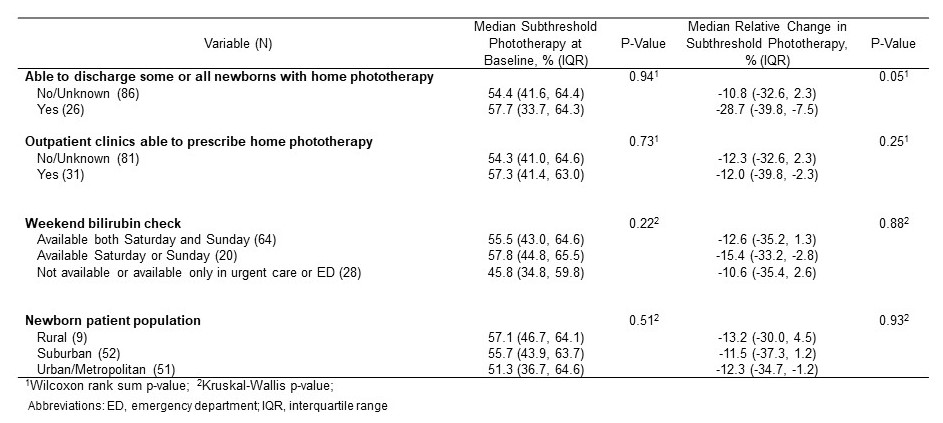Hospital Medicine 1: Quality Improvement
Session: Hospital Medicine 1: Quality Improvement
547 - Barriers Associated with Reducing Subthreshold Phototherapy for Neonatal Hyperbilirubinemia
Saturday, April 26, 2025
2:30pm - 4:45pm HST
Publication Number: 547.3637
Pearl Chang, Seattle Children's Hospital / University of Washington, Seattle, WA, United States; Ellen K. Kerns, University of Nebraska Medical Center, Omaha, NE, United States; Matthew D. Garber, UF COM-Jacksonville, Jacksonville, FL, United States; Carole H. Stipelman, University of Utah School of Medicine, Salt Lake City, UT, United States; Leela Sarathy, Mass General for Children, Boston, MA, United States; Kaitlin Widmer, University of Colorado School of Medicine, Parker, CO, United States; Elisa Hampton, University of Virginia, Charlottesville, VA, United States; Julie Gallois, Louisiana State University School of Medicine in New Orleans, New Orleans, LA, United States; Eliza Bakken, Childrens Hospital of Philadelphia, Philadelphia, PA, United States; Jennifer Monti, American Academy of Pediatrics, Itasca, IL, United States; Sloane E. Magee, The American Academy of Pediatrics, Itasca, IL, United States; Katherine M. Satrom, University of Minnesota, Minneapolis, MN, United States
- PC
Pearl Chang, MD (she/her/hers)
Pediatric Hospitalist
Seattle Children's Hospital / University of Washington
Seattle, Washington, United States
Presenting Author(s)
Background: We launched a national, multisite quality improvement (QI) initiative to reduce subthreshold phototherapy (PT) use coinciding with the release of the revised American Academy of Pediatrics (AAP) clinical guideline for neonatal jaundice. Baseline subthreshold PT use was high, and remained high even after a significant reduction in the intervention period.
Objective: To assess health system and provider-perceived barriers associated with reducing inpatient subthreshold PT use
Design/Methods: We used data collected from the Learning and Implementing Guidelines for Hyperbilirubinemia Treatment (LIGHT) QI collaborative, which aimed to reduce subthreshold PT for newborns >=35 weeks’ gestation. We defined subthreshold PT as a starting total serum bilirubin (TSB) >=0.3 mg/dL below the AAP treatment threshold. In a post-project survey, we asked site leaders the open-ended question, “Why do you think providers start subthreshold PT at your hospital?” We compared the relative reduction in the median percentage of subthreshold PT encounters between the 12-month baseline period (2/2022-1/2023) and 12-month intervention period (2/2023-1/2024) for 3 health system characteristics: patient population, availability of home PT and outpatient weekend TSB checks. Variables were reported by site leaders via multiple-choice surveys. Statistical significance (p < 0.05) was assessed by the Wilcoxon rank sum or Kruskal-Wallis test, as appropriate.
Results: Of the 146 sites enrolled in LIGHT, 112 completed >=75% of data entry plus the project surveys and were included for analyses. Baseline median subthreshold PT use were similar across health system characteristics. Provider-perceived barriers to reducing subthreshold PT are in Table 1. The top reason was the lack of timely outpatient follow up, especially on weekends (64/112, 57%). However, we did not find statistically significant associations between any of the health system characteristics and subthreshold PT reduction, though there was a notable difference in subthreshold PT reduction between sites who are (-28.7%) and are not able to discharge newborns with home PT (-10.8%, p=0.05, Table 2).
Conclusion(s): Despite >50% of sites reporting difficulty with outpatient follow-up as a barrier, sites with more outpatient access were not more successful in reducing subthreshold PT use. This suggests that a provider decision for starting subthreshold PT is more complex than resource availability and other barriers may play a more frequent role than reported. We may have been underpowered to detect a difference among sites with and without home PT access, a target for future studies.
Table 1. Provider-perceived barriers to reducing subthreshold phototherapy use (N=112).

Table 2. Associations between health system characteristics and median relative reduction in subthreshold phototherapy.

Table 1. Provider-perceived barriers to reducing subthreshold phototherapy use (N=112).

Table 2. Associations between health system characteristics and median relative reduction in subthreshold phototherapy.


